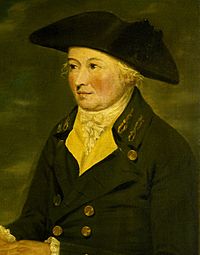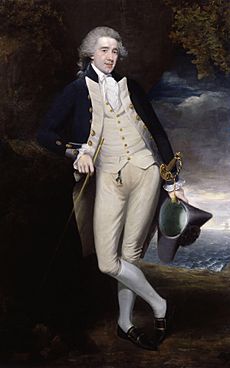Sea Fencibles facts for kids
The Sea Fencibles were special groups of people who helped defend the coast, mostly during the French Revolutionary and Napoleonic Wars. They were like a local navy that stayed close to shore. Their main job was to protect the coast and stop enemy ships from getting too close.
The idea for Sea Fencibles first came up in 1793. A British Navy captain named Home Popham organized fishermen to guard against French ships near Nieuwpoort, Belgium. Later, the British Admiralty (the Navy's leaders) decided to create more Sea Fencible groups along the coasts of England and Ireland. From 1804, these groups were also supported by strong coastal forts called Martello towers.
Captain Popham's Sea Fencibles were often merchant sailors using their own boats. They had special permission, called letters of marque, to capture enemy ships if they had the chance. The Navy gave them uniforms and weapons. It also protected them from being forced into the Navy by press gangs. The British Admiralty stopped using Sea Fencible units in 1810.
Contents
What Were the Sea Fencibles?
How They Started in Britain
Quick facts for kids Sea Fencibles |
|
|---|---|
| Active | 1798–1810 |
| Country | United Kingdom |
| Branch | Royal Navy |
| Role | Coastal defence |
| Size | 30,000 men by 1805 |
Captain Home Popham of the Royal Navy came up with the Sea Fencibles idea. This was while he was helping the British Army in Flanders during the French Revolutionary Wars. In July 1793, Popham was in Ostend, making sure Navy ships delivered supplies. In October, a French army attacked Nieuwpoort, a town held by the British.
To help defend Nieuwpoort, Popham gave weapons to the town's fishing boats. He then led them to fight French ships along the coast. Popham called his group the "Sea Fencibles." He compared them to the Highland Fencible Corps, which were land-based defense groups in Scotland.
The French eventually stopped their attack on Nieuwpoort. Both the Army's commander, the Duke of York, and General Charles Grey said Popham's actions were very important. They noted that arming the local fishermen helped keep Nieuwpoort under British control.
Popham was very impressed with how well the Sea Fencibles kept enemy landing boats away. In 1798, when it looked like France might invade Britain, Popham suggested creating a similar group. This new group would defend the British coast from Cornwall to the Firth of Forth.
On February 1, Popham went to Hastings with the Admiralty's plan. They wanted to create a group of Sea Fencibles to man the defenses near Hastings and Pevensey Bay. More than 200 people, mostly sailors, signed up right away.
Britain's Sea Fencibles were officially formed on May 14, 1798. Their job was to protect the coast, both on land and at sea. This included fishermen and others who worked in ports and along the coast. They were also protected from being forced into the Navy. Their tasks included defending Martello towers, patrolling beaches for invaders, and using armed commercial boats to capture enemy ships.
How They Were Organized
The Sea Fencibles were split into 36 companies. Each company was in charge of watching and defending a part of the coastline. Three Royal Navy captains and up to six lieutenants led each district. These district captains reported to the Director of Sea Fencibles, who was an admiral. In 1803, this was Sir Edmund Nagle.
Sea Fencible volunteers were taught how to use weapons. They had to man watchtowers, signal towers, and gun batteries along the coast. Those who owned commercial boats, like fishermen, received up to four cannons for their boats. They also got training on how to use and care for these guns. The Navy even provided some armed boats where private ones were not enough.
A Sea Fencible member would train one day a week. They could also choose their own Petty Officers, with one officer for every 25 men. All Sea Fencibles received a certificate that stopped them from being forced into the Navy. This protection was a big reason why many joined.
The Sea Fencibles also had special permission to capture French or Spanish merchant ships. If they seized a ship, they would get a share of the money when it was sold. Their fleet included small ships like colliers and hoys. These were changed to carry guns, usually two at the front and two at the back. The Navy gave them guns, ammunition, and gunpowder. Ship owners had to work with the Royal Navy and were paid for their ships and time.
For example, in 1804, the Navy hired 16 hoys at Margate. The Navy put one regular Navy man as master on each boat, along with nine Sea Fencibles.
Joining the Sea Fencibles

Here is a newspaper advertisement from 1798, asking people to join: "ANY Men willing to enroll themselves as SEA FENCIBLES, to defend the coast against an Enemy, are to apply to Capt. Edge, at Southwold. They are only required to attend one day in the week, to exercise at the pike and guns a few hours. They will be allowed a shilling each on those days. If called up on actual service, they will get the pay of an able seaman."
Many people joined the Sea Fencibles quickly, with 23,500 volunteers in the first four years. Officers also joined fast, especially younger captains who wanted a command. By 1803, one-third of Sea Fencibles captains had been promoted in the last year. Being a Sea Fencibles commander also offered easier service with full pay. This appealed to older captains whose Navy careers were ending. The oldest captain, Sir Edmund Nagle, had served at sea for over 30 years before leading the Sea Fencibles at Shoreham-by-Sea in 1803.
Home Popham himself was put in charge of the area between Beachy Head and Deal. This was the area thought to be most at risk of a French invasion. Another famous Sea Fencible was Francis Austen, a naval captain and future admiral. He was the brother of the famous writer Jane Austen. He helped create and organize a Sea Fencibles group to defend a part of the Kentish coast. His base was the Royal Harbour of Ramsgate.
In September 1803, it was reported that all seafaring men in Gloucester were joining the Sea Fencibles. This was to get protection from the press gang.
What They Did in Action
The Sea Fencibles were involved in several actions. On November 13, 1798, a French privateer (a private ship allowed to attack enemy ships) appeared near Hastings. Captain E.H. Columbine of the Sea Fencibles took some of his men on a boat called Lion. They chased the French ship and captured it after a short fight. The French ship was the Success, and Captain Columbine praised the "zeal and readiness" of the Hastings men.
On January 9, 1799, a French privateer captured a British ship called Susannah near Dartmouth. The Brixham Sea Fencibles saw this happen. They took a boat, armed with only muskets and pikes, and successfully recaptured the Susannah and its French crew.
On March 11 of the same year, the Margate Sea Fencibles were also successful. They saw a small enemy boat attacking two British ships. About 40 or 50 Sea Fencibles quickly went out in three boats. They recaptured the two British ships, and the privateer sailed away.
On June 13, 1804, a British hired boat, the Princess Augusta, fought a 14-gun French privateer near Huntcliff. The fight lasted almost four hours. The Princess Augusta was damaged but only had three men wounded. The French ship left when two schooners with Sea Fencibles from Redcar approached.
The Sea Fencibles also helped as a coastguard or lifeboat service. In 1800, when the ship HMS Brazen crashed, the Sea Fencibles tried to rescue the crew. In January 1809, when HMS Pigeon was wrecked near Margate, the Sea Fencibles helped save the survivors.
In January 1810, Sea Fencibles from Happisburgh and Winterton used new Manby mortars to rescue people from two ships caught in a storm.
On February 3, 1810, a French privateer captured a ship near Newhaven. Five small boats of Sea Fencibles tried to get it back but were outgunned. They did manage to save another boat from being captured. Later that month, it became clear that the threat of invasion by Bonaparte was over. So, the Sea Fencibles were officially disbanded.
River Fencibles
In 1798, boatmen and other river workers on the River Thames formed their own groups called River Fencibles. These were officially set up in 1803 as the "Corps of River Fencibles of the City of London." By 1804, they had uniformed officers.
Members of the Corps helped escort the boat carrying Lord Nelson's body along the Thames. This was during his state funeral in 1806.
In 1807, some River Fencibles sailed to Copenhagen. They helped bring back Danish ships captured after the second Battle of Copenhagen. The Greenwich River Fencibles, for example, sent two officers and 126 men to Copenhagen.
The City of London, Loyal Greenwich, and Royal Harbour River Fencibles also sent men to the Walcheren expedition in 1809. About 300 Fencibles volunteered for Copenhagen, and about the same number for the Walcheren Expedition. The Corps was disbanded in 1813.
Irish Sea Fencibles
The British Admiralty set up 20 Sea Fencible units in Ireland. They also built a network of Martello towers to protect the Irish coastline. The number of men and boats in each area was different. The British were sometimes worried about how reliable these units were. This was especially true after Robert Emmet's uprising in Dublin in 1803.
In 1804, the Irish Sea Fencibles had about 28 armed vessels. These included a brig, three galliots, and several sloops. They usually carried two 18-pounder guns and two 18-pounder carronades. The owners usually provided a small crew. The plan was for Sea Fencibles to join them when the boats went to sea.
Sea Fencibles in Canada
During the War of 1812, there were Sea Fencible units in New Brunswick, Canada. They were part of local battalions in St. John, Charlotte, and Northumberland counties. Their job was to protect port facilities in the colony. These units were made up of seafaring men from coastal towns. They seem to have all disbanded after the war ended.
From 1833 to 1867, there was a unit called the Saint John Sea Fencibles. This group mostly worked as an artillery unit. Its officers and men wore naval uniforms.


